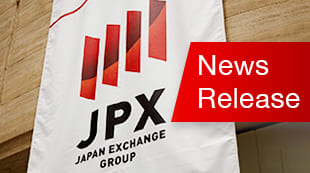Search results 141-150 / 10651
- sort:
- relevance
- latest

Trading Methods | Derivatives | Japan Exchange Group Overview How to Determine Contract Price by Itayose Method Rule to Determine Contract Price by Itayose Method Futures and options trading is conducted on an individual auction basis according to the price and time priority rule. In the individual auction in a regular session, a contract price is determined by the Zaraba method. Transactions by the Zaraba method are executed among the matching orders according to the price and time priority rule at a price where the lowest offer and the highest bid are matched. In the individual auction in an opening auction and closing auction and at the resumption of trading after a temporarily trading halt, a contract price is determined by the Itayose method described below. A contract price determined by the Itayose method is the price that maximizes the traded volume and minimizes the untraded volume according to the price and ...

Overview of Specifications | Carbon Credit Market | Japan Exchange Group Backgraound Overview In order to achieve its goal of carbon neutrality by 2050, in February 2023, the Japanese government announced the introduction of an "emissions trading system" as part of the carbon pricing system design in its "Basic Policy for the Realization of GX." Trial trading is scheduled to begin in FY2023 and full-scale operation in FY2026, so as part of this, there are expectations for a Carbon Credit Market to be created in FY2023. Based on the knowledge and market operation experience gained from the "Technical Demonstration Project for Carbon Credit Market" commissioned by the Ministry of Economy, Trade and Industry (METI) in FY2022, Tokyo Stock Exchange, Inc. (TSE) has established a Carbon Credit Market. As part of METI's green transformation project for FY2024 (operation of the GX League secretariat and development of frameworks to support voluntary emissions ...

Market Participants | Carbon Credit Market | Japan Exchange Group Registration Requirements Application for New Market Participant Registration Designation of additional GX credits Cancellation of registration, change of registration details, etc. Application Process for Registration In order to participate in Carbon Credit Market, applicants must register as a Market Participants in Tokyo Stock Exchange. The list of Carbon Credit Market Participants is published on this website. Market participants must designate the credits (J-Credits and GX credits) they wish to trade. Applicants must meet the following a. through f. to register as a Market Participant. a Being a corporation, government or local government, or nin-i dantai (voluntary organization) b Having a system in place to ensure stable operations 1 c Having sound management, including having sufficient social credibility to be a TSE trading participant and not being subject to the control or influence of any party lacking social credibility or any ...

Rulebooks | Carbon Credit Market | Japan Exchange Group Terms and Conditions Terms and Conditions-Supplementary Provisions Others Terms and Conditions Terms and Conditions-Supplementary Provisions Terms and Conditions for the Carbon Credit Market System Written Confirmation that the Applicant Has no Relationship with Anti-social Forces...

Shareholder Services and Book-Entry Transfer System for Foreign Stocks, etc. | Clearing & Settlement | Japan Exchange Group Dividend Payment Record Date of Shareholders Eligible for Dividend Other Rights such as Subscription rights Exercise of Voting Rights at General Shareholders Meetings Book-Entry Transfers from JASDEC to Securities Companies Foreign stocks are settled under the business regulations relating to the depository and book-entry transfers for foreign stocks, etc. of Japan Securities Depository Center, Inc. (JASDEC). In this system, securities companies and banks, etc. establish participant accounts in JASDEC and general investors establish customer accounts in securities companies or banks, etc. in accordance with the rules of JASDEC and Tokyo Stock Exchange, Inc. (TSE). Regular transactions of foreign stocks listed on the TSE market are settled, in the same way as domestic stocks, via book-entry transfer on the third business day counting from the trade day (T+2) based on the ...

Clearing & Settlement Organization | Clearing & Settlement | Japan Exchange Group Japan Securities Clearing Corporation (Clearing Organization) Japan Securities Depository Center (Settlement Organization) The main functions of the clearing organization are the assumption of obligations from participants, netting, settlement instructions, and settlement guarantees. Assumption of obligations When transactions are executed, sellers are obligated to deliver securities and the have the right to receive cash, and buyers are obligated to pay cash and have the right to receive securities. The clearing organization assumes these obligations and acquires these rights as a central counterparty (CCP) between sellers and buyers. As a result of this assumption of obligations, the counterparty for settlement is changed from the original trading counterparty to the clearing organization. This allows all participants to trade without worrying about the credit risk of the trading counterparty. Thus, clearing operations become more efficient. Netting Netting is conducted in trading cleared in a clearing organization ...

Summary | Clearing & Settlement | Japan Exchange Group Summary Functions / Roles of Organizations related to Trading, Clearing and Settlement (Example of cash equity) The operational procedure from trading to settlement is divided into three phases; 'trading in markets,' 'clearing at the clearing organization' and 'settlement at settlement organizations.' In Japan, there are four financial instruments exchange markets for trading securities, one of which is Tokyo Stock Exchange, Inc. (TSE). Clearing services for all securities transactions on these markets are provided by Japan Securities Clearing Corporation (JSCC). Trades cleared by JSCC are settled at the following organizations: - Japan Securities Depository Center, Inc. (Stocks and convertible bonds etc.) - The Bank of Japan (Japanese government bonds) - The Bank of Japan or commercial banks which JSCC designates as fund settlement banks (Funds)...

Reform of Securities Clearing and Settlement System | Clearing & Settlement | Japan Exchange Group The reform of securities clearing and settlement system refers to a series of regulatory reforms and reform of related institutions addressed towards mitigating risks and enhancing the efficiency of securities clearing and settlement. Specifically, the reform included upgrading related regulations, introducing DVP settlement for securities, establishing clearing houses such as Japan Securities Clearing Corporation (JSCC) and finally, in January 2009, implementing paperless share certificates. Tokyo Stock Exchange, Inc. (TSE) as a market operator actively joined in the discussion about these reforms from the earliest phases. This page will provide some materials on the series of reforms, which were posted on the website of the Reform Promotion Center for Securities Clearing and Settlement System previously (this website is now closed). The Center, established in April 2002 to promote the reform, had a role in capturing the overall picture and ...

Shortening of Settlement Cycle for Stocks and Other Securities (T+2) | Clearing & Settlement | Japan Exchange Group In response to the trend on shortening the settlement cycle for stocks and other securities in major overseas countries, Tokyo Stock Exchange, Japan Securities Clearing Corporation, and Japan Securities Dealers Association formed the Working Group on Shortening the Settlement Cycle for Stocks and Other Securities in July 2015, and facilitated a cross-industry study for implementing a T+2 settlement cycle in the Japanese market. As a result of the study, it was decided to implement T+2 settlements effective July 16, 2019 (Tues.) (for executed trades), which means the date of delivery of shares and other securities occurs one business day earlier from the date of transaction than previously, and delivery is made two business days after the trade date. (Note) ・Please also refer to the website of the Japan Securities Dealers Association (...

Establishment of Listing System for Class Shares with Voting Rights | Japan Exchange Group Report on the Listing System for Class Shares with Voting Rights (released Jan. 16, 2008) In July 2007, based on the interim report (released Mar. 27, 2007) by the Listing System Development Advisory Panel and the implementation plan of the Comprehensive Improvement Program for the Listing System 2007, Tokyo Stock Exchange (TSE) established a Working-Level Panel consisting of practitioners from listed companies, securities firms, lawyers, etc., and academics for the purpose of formulating basic ideas on what requirements must be met for Voting Class Shares to be considered as “respecting shareholders‘ rights.” Please refer to the "Report on the Listing System for Class Shares with Voting Rights" and "Public Announcement (including Summary of Report)". Report on the Listing System for Class Shares with Voting Rights (in Japanese only) Public Announcement (including Summary of Report) (in Japanese ...














